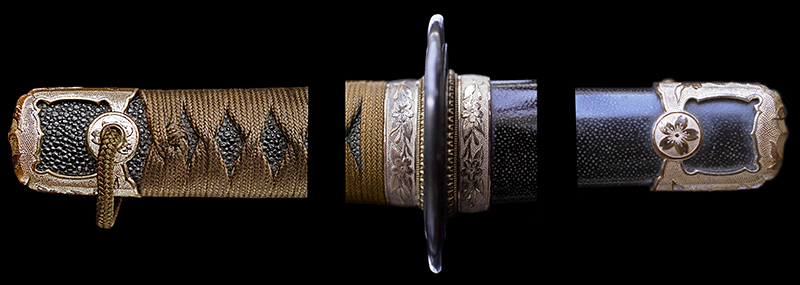ҠCҢR‘ҫ“ҒҢ^ҢR“ҒҒ@(1)0
Ғu“VҸЖҺR’bҳBҸкҚмҒvҒE–і–јҒuҠЦҒvҚҸҲу
"Tenshōzan Forging Workshop Saku",
"Seki inspection mark"
“VҸЖҺR’bҳBҸкҚм
•WҸҖҢ^Ғ@–Б:
“VҸЖҺR’bҳBҸкҚмҒAӢЯ‘г“ҒҒA(җn’·: 63.8ҮpҒE”ҪӮи: 1.6Үp)ҒA •sзцҚ|“ҒҒAҠCҢRҒE“VҸЖҺR’bҳBҸҠ•WҸНҚҸҲуҒA
Қ•ҢӨҸoҺL”зҠӘ–ШҸвҒAҗШүHҺOҺнҳZ–ҮҒAғnғoғL—ҜӮЯҒAҠЫ•RүҺҺиҒAӢаӢп: җЈҢЛ“tӢаҒA
ҺmҠҜ“ҒҸҸ•tҒ@(‘S’·: 96.0Үp)
Tenshōzan Forging Workshop
Standard
type: Mei: Tenshōzan Tanren-jō Saku,
Modern-sword,Ғ@(Blade length: 63.8Үp, Curvature: 1.6Үp),
Unti-rust-steel blade, Navy Tenshōzan Forging Workshop's trademark
stamp,
Black polished-and-lacqurered rayskin binding wooden scabbard, Habaki
stopper,Ғ@Metal parts: Seto-plating,
Round string knot loop, With the officer knot, Overall length: 96.0Үp
Ғ@Ғ@Ғ@Ғ@
|
Ғ@Ғ@Ғ@Ғ@Ғ@Ҡ•Ӣа‘Ө–КӮЖҗ§Һ®ӢK’иӮМҠЫ•RҺи
|
үҸӢаҒEҗШүHӮЖ’ХҒEҢыӢаҒ@
|
Ғ@Ғ@Ғ@Ғ@Ғ@Ғ@Ғ@җО“Л‘Ө–КҒ@Ғ@Ғ@Ғ@Ғ@Ғ@Ғ@ |
The round string Knot loop of formality regulation.
Ҡҷ‘q“VҸЖҺR’bҳBҸҠ
ҒuҠCҢRҒEҠҷ‘q“VҸЖҺR’bҳBҸҠҒvӮЖ•WӢLӮ·ӮйҒBҒu“VҸЖҺRҒvӮМ‘OӮЙҒuҠҷ‘qҒvӮЖ•tӮӯӮМӮНҒAҠЦӮЙҒu“VҸЖҺR‘еҺR“ҒҢ•ҒvӮЖӮўӮӨ’b“ҒҸҠӮӘҚЭӮБӮҪҲЧ
ӮЙҒAӮ»ӮкӮЖӢж•КӮ·ӮйҲУ–ЎӮӘ—LӮБӮҪ—lӮҫҒB
ҒuҠҷ‘q“VҸЖҺR’bҳBҸҠҒvҺ©‘МӮНҒA“ҒҢ•ҸӨ(–{“X‘еҚг)ӮМ•һ•”‘P“сҳYӮӘҢoүcӮ·ӮйҠCҢRҢд—p’BӮМ–ҜҠФҠйӢЖӮЕӮ ӮБӮҪҒB
•һ•”ӮНҗГүӘӮМҺO“ҮҒAҠҷ‘q“VҸЖҺRӮЙ“ҒҸ Ӯр•шӮҰҚм“ҒӮМҢoүcӮЙӮ ӮҪӮБӮҪҒB
–ә–№ӮМүpҺЎӮНҸIҗн’јҢгӮМ“ъ–{“ҒӢ~ҚПӮЙ–z‘–ӮөӮҪ’ҶҗSҗl•ЁӮҫӮБӮҪҒB
Ҡҷ‘q“VҸЖҺRӮМ“ҒҗgӮНҒA•һ•”ӮМ’bҳBҸҠӮҫӮҜӮЕӮИӮӯҒAҠЦӮМ“ҒҸ ӮӘҚм“ҒӮөӮД–БӮрҗШӮиҒA’b–иҢӨӮ¬ӮМҸу‘ФӮЕ”[“ьӮіӮкӮҪ•ЁӮа‘ҪӮўҒB
Ҹн’“Ӯ·ӮйҠCҢRӢZҠҜӮӘҢҹҚёӮөӮДҢҹҚёҲуӮрҚҸҲуӮөҒAҚЕҸIҺdҸгӮ°ӮН’bҳBҸҠӮМҢӨҺtӮӘҢӨ–ҒӮөӮҪҒB
Ғ@
–{“ҒҗgӮН“ҒҸ –БӮЕӮНӮИӮӯҒu“VҸЖҺR’bҳBҸкҚмҒvӮЖ–БӮӘҗШӮБӮДӮ ӮйӮМӮЕҒAҠҷ‘q“VҸЖҺR’bҳBҸҠӮМ“ҒҸ ӮӘҚм“ҒӮөӮҪ•ЁӮ©ҒAҠЦӮМҒu“VҸЖҺR‘еҺR“Ғ
Ң•ҒvӮЕҚм“ҒӮөӮД”[“ьӮіӮкӮҪ•ЁӮ©ӮН’иӮ©ӮЕӮН–іӮўҒBҺKӮСӮМҸу‘ФӮ©ӮзҒA“ҒҚЮӮН•sзц(ӮөӮгӮӨ)Қ|ҒҰӮЕӮ ӮлӮӨҒBҒ@Ғ@Ғ@Ғ@Ғ@Ғ@Ғ@ҒҰ ‘ПҺKҚ|“ҒҺQҸЖ
Kamakura Tenshōzan Forging Workshop
Usually, this forging workshop is called "Navy Kamakura Tenshōzan
Forging Workshop." It was attached with "Kamakura" before "Tenshōzan"
in order to distinguish from it, since the sword workshop a "Tenshōzan
Ōyama Sword Co," was in Seki. "Kamakura Tenshozan Forging
Workshop" itself was the private enterprises under exclusive contract
with a navy which Zenjirō Hattori of a dealer in swords manages.
Mr. Hattori set the swordsmith under exclusive contract to
Mishima in Shizuoka, and Kamakura Tenshōzan Forging Workshop, and
managed the sword making. Mr. Eiji, his daughter's son-in-law, was the
central figure who was busy about the Japanese sword relief just behind
the end of the war.
Kamakura Tenshōzan Forging Workshop's blade has not only
Hattori's forging workshop but many things which the swordsmith of Seki
carried out the sword making, engraved the Mei, and were supplied in
the state of the blacksmith polish.
The navy technical official who resides in Kamakura Tenshōzan
Forging Workshop permanently inspected the delivery blade, and stamped
the inspection mark on the swod-tang of the acceptable product.
The polisher of Kamakura Tenshōzan Forging Workshop impressed
into the navy did the polish of the last finish of the blade.
The blade of printing has engraved not a swordsmith Mei but
"Tsukuru Tenshōzan Forging Workshop" Mei. Since there was no swordsmith
Mei, Kamakura Tenshōzan Forging Workshop's swordsmith may have made
this blade. However, a decision is impossible.Ғ@Probably, the
state where the swod-tang rusts to the blade is a unti-rust or
stainless steelҒҰ.
Ғ@Ғ@Ғ@Ғ@Ғ@Ғ@Ғ@Ғ@Ғ@Ғ@Ғ@Ғ@Ғ@Ғ@Ғ@Ғ@Ғ@Ғ@Ғ@Ғ@Ғ@
Ғ@Ғ@Ғ@Ғ@Ғ@Ғ@Ғ@Ғ@Ғ@Ғ@Ғ@Ғ@Ғ@Ғ@Ғ@Ғ@Ғ@Ғ@Ғ@Ғ@Ғ@Ғ@Ғ@Ғ@Ғ@Ғ@Ғ@Ғ@Ғ@ҒҰ Refer to the unti-rust steel
(җј •qҳaҺҒҸҠ‘ )
1
Ғ@Ғ@Ғ@Ғ@Ғ@
–і–јҒuҠЦҒvҢҹҚёҲу
•WҸҖҢ^Ғ@–і–Б:Ғ@ҠЦҗn•ЁҚHӢЖ‘gҚҮҢҹҚёҚҸҲуҒAӢЯ‘г“ҒҒA(җn’·:69.9ҮpҒE”ҪӮи:1.7Үp)ҒE–ШҸв(Қ•ҢӨҸoҺL”зҠӘ)
ӢаӢп: җЈҢЛ“tӢаҒAҺmҠҜ“ҒҸҸ•t (‘S’·: 100.5Үp)
"Seki" inspection mark
Standard
type: Mu-mei: Seki Cutlery Industrial Guild's inspection mark,
Modern-sword,
(Blade length: 69.9Үp, Curvature: 1.7Үp), Black polished-and-lacqurered
rayskin binding
wooden scabbard, Spring clip,Ғ@With the officer knot,
Overall length: 100.5Үp

|
Ғ@Ғ@ҠЦҗn•ЁҚHӢЖ‘gҚҮӮМҢҹҚёҲу
Ғ@Ғ@Seki Cutlery Industrial Guild's inspection mark.
|
Ғ@
Ғ@ҒuҠЦҒvӮМҚҸҲу
|
ҸүҠъҢҹҚёҲу
The early inspection mark.
|
“а–ұҸИ—ЯҢҹҚёҲу
Inspection mark of the ministerial
ordinance of the Department of the Interior.
|
Ғ@Ғ@ҢsӮЙҒAҠЦҗn•ЁҚHӢЖ‘gҚҮӮӘ•iҺҝӮр•ЫҸШӮ·ӮйҸүҠъҢҹҚёҚҸҲуӮМҒuҠЦҒvӮӘ‘ЕҚҸӮіӮкӮДӮўӮйҒB
Ғ@Ғ@җn–дӮН•tӮўӮДӮўӮйӮӘҒA‘ӯӮЙү]ӮнӮкӮйҸәҳa“ҒҒB—рҺj“IҺ‘—ҝүҝ’lӮНҚӮӮўҒBҒ@
Ғ@Ғ@Ӣ@ҠB’b‘ўӮМ’bҳB“ҒӮ©‘fү„“ҒӮ©ӮН’иӮ©ӮЕ–іӮўҒB
Ғ@Ғ@ҢГҺ®–{’bҳB“ҒӮЙӮН–БӮрҗШӮйӮ©ҒA–іҢҹҚё(ҠЦҗn•ЁҚHӢЖ‘gҚҮӮМҢҹҚё‘ОҸЫҠO)ӮМҲЧҒAӮұӮӨӮөӮҪҚҸҲуӮН‘ЕӮҪӮИӮўҒB
Ғ@Ғ@Ҹәҳa16”NӮ©ӮзӮМғGғAҒ[ғnғ“ғ}Ғ[ӮЙҲЛӮйҢГҺ®”ј’bҳBӮжӮиҲИ‘OӮМҚмҒB
Ғ@Ғ@(ҠЦҗn•ЁҚHӢЖ‘gҚҮӮМҢҹҚёҚҸҲуӮНҒuҠЦҒvӮ©Ӯз“а–ұҸИ—ЯӮМҒuҚчӮМ’ҶӮЙҸәҒvҚҸҲуӮЙ•ПӮнӮБӮДӮўӮй)
Ғ@Ғ@Ғ@Ғ@Ғ@Ғ@Ғ@Ғ@Ғ@
Ғ@Ғ@Ғ@Ғ@Ғ@Ғ@Ғ@Ғ@Ғ@Ғ@Ғ@Ғ@Ғ@Ғ@Ғ@Ғ@Ғ@Ғ@Ғ@Ғ@Ғ@Ғ@Ғ@Ғ@Ғ@Ғ@Ғ@Ғ@Ғ@Ғ@Ғ@Ғ@Ғ@Ғ@Ғ@Ғ@Ғ@Ғ@ҒҰ җнҺһүәҠЦӮМ“ъ–{“ҒҺQҸЖ
|
(Ҹ¬“ҮҚҺ‘ҘҺҒҸҠ‘ )Ғ@
2013”N11ҢҺ3“ъӮжӮи
ғyҒ[
ғWӮМғgғbғvӮЦҒЈ





















